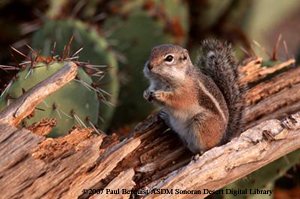Animal Fact Sheet: Harris's Antelope Squirrel |
Identifying Features The Harris's antelope squirrel (Ammospermophilus harrisii) is gray in color with some brown on its upper front and back legs. It has a white stripe on its side, a white underbelly and a bushy black tail that it often carries arched over its back.
|
 |
Adaptations Despite the hot desert weather, you will often see these squirrels dashing about in the middle of the day. They will stay out in the heat collecting food until their body reaches its maximum temperature and then they will rest in the shade until that temperature has lowered. Their tail is often held over their head like an umbrella helping to shade their bodies. |
Habitat This squirrel prefers rocky desert habitats that contain cactus and shrubs. |
Range They can be found in western, central and southern Arizona and extreme southwest New Mexico and northwestern Sonora, Mexico. |
Wild Status In Arizona, antelope squirrels are classified as non-game animals by the Arizona Game and Fish Department and are protected. They are not considered to be threatened or endangered. |
Diet They feed on a variety of desert plants that range from the fruit and seeds of cactus like barrel cactus, cholla cactus and prickly pear cactus. They also will eat mesquite beans, insects and an occasional mouse. |
Predators Coyotes, hawks, snakes, bobcats, and domestic cats and dogs are just a few of their predators. |
Home Harris antelope squirrels live in underground burrows that they dig under a shrub like creosote or jojoba and under mesquite and palo verde. |
Life Span Life span of a wild antelope squirrel is usually between 2-4 years. In a zoological setting, they have been known to live 11 years. |
Size They weigh 4.0-5.0 oz (113-150g); their body length without the tail is 8.5-10.0 inches (22-25cm), and their tail is 3.0-4.0 inches (74-94mm) in length. |
Extra Fun-facts
|
 ©Copyright 2008, Arizona-Sonora Desert Museum
©Copyright 2008, Arizona-Sonora Desert Museum